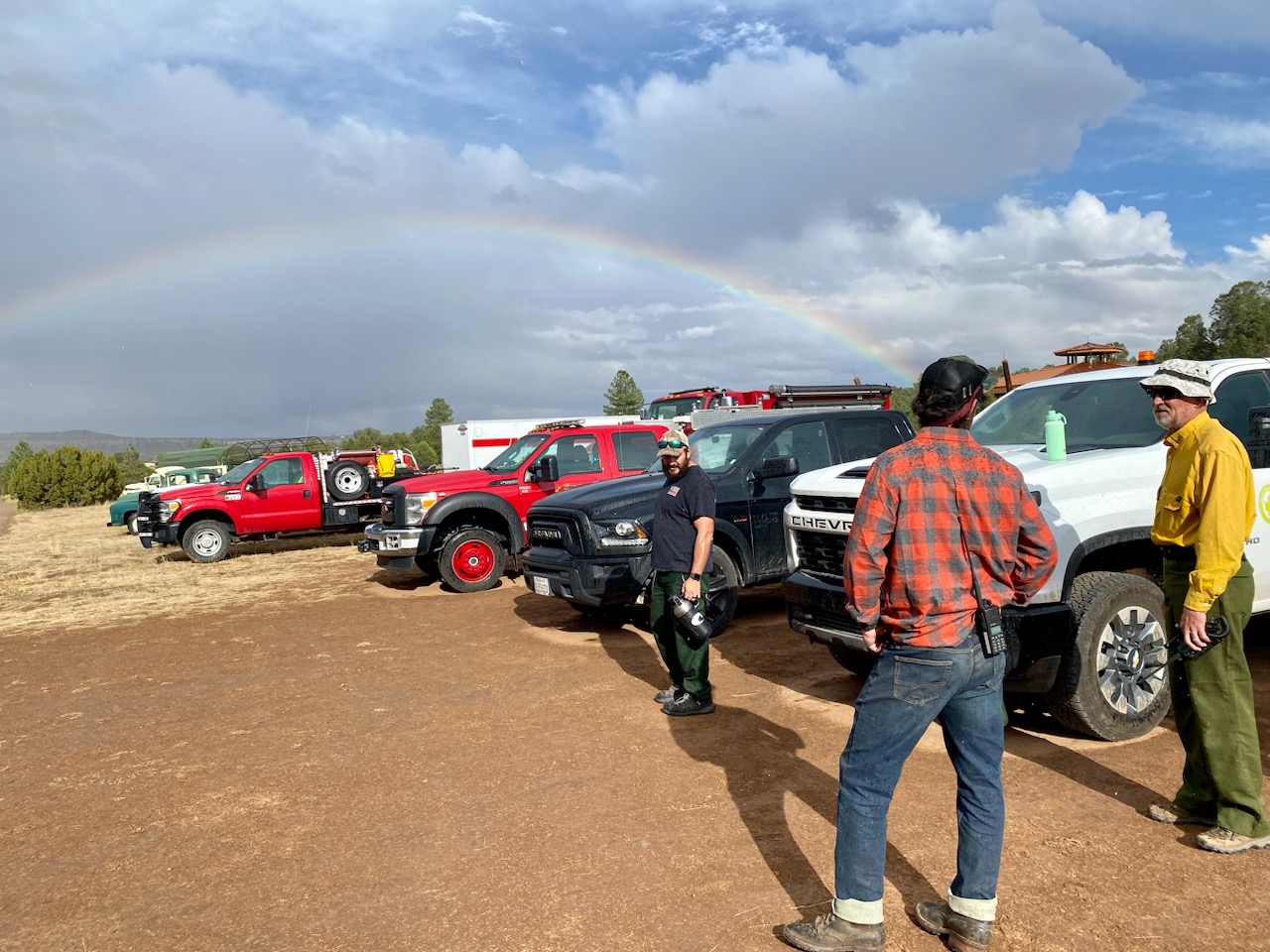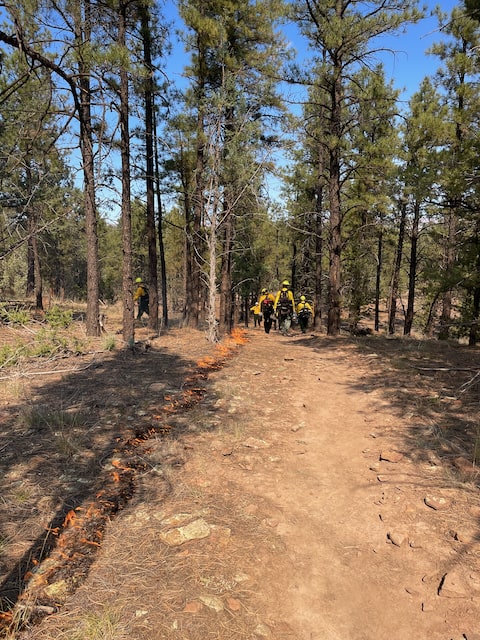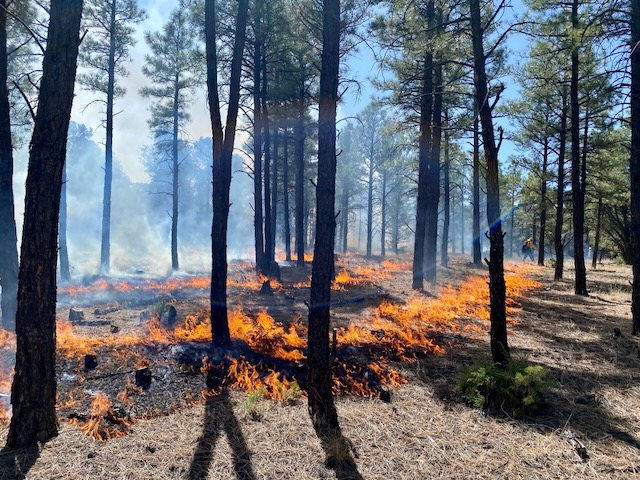
Third Time’s the Charm: Burning at Cottonwood Gulch
Editor’s note: Carlos Saiz is the Southwest Fire and Fuels Coordinator for the Forest Stewards Guild. Sam Berry is the Guild’s Southwest Associate Director and a Fire Learning Network Project Lead for work in New Mexico. In this blog, they describe a successful prescribed burn in New Mexico that managed to bring together a broad range of collaborators, achieved ecological benefits to the land, and encouraged community members to see prescribed fire in a new light. All photos credit to the authors unless otherwise indicated.
When I (Carlos) first arrived at the Cottonwood Gulch Expeditions Basecamp for a prescribed burn in 2015, I was a rookie firefighter, excited to start my career and looking to get fire experience at every opportunity. The Basecamp is located at the foothills of the Zuni Mountains. It’s mostly ponderosa pine mixed with pinyon juniper forests with a few cottonwoods along a stream as the name would suggest. It is also the heart of a large, expedition-based youth education program with hundreds of young people coming and going throughout the year to learn about nature and the outdoors. The Gulch’s staff have engaged in actively restoring their lands to protect themselves from fire, but more importantly, as part of their mission to demonstrate to campers and neighbors what responsible forest management looks like.

The Long Road to Burn Day
Returning with a collaborative team that had successfully burned at the camp twice before, preparations began in 2021 with the Guild, The Ember Alliance, the local volunteer fire department (VFD), The Nature Conservancy, and Cottonwood Gulch to implement another burn. Unfortunately that fall was too wet to complete the burn, and in the spring of 2022, we made another attempt. We were nearly hitting the call button on our phones to mobilize resources to the site when the forecast changed – we had to call off the burn due to dry and windy conditions.
On that same day 150 miles northeast of the unit, the Las Dispensas prescribed fire was ignited, which eventually became New Mexico’s largest wildfire: the Hermit’s Peak fire. This tragedy was then compounded when a nearby winter pile burn flared up in the spring and turned into the Calf Canyon wildfire. During an unprecedented wind event, these two escaped prescribed burns combined into one fire. Similar to what happened after the Cerro Grande Fire in 2000, the atmosphere around prescribed burning immediately darkened, bringing new challenges and adversities for years to come. The Guild and Gulch postponed the burn to weather that storm and wait for better conditions.
When I returned to the area in 2023, I had plenty of fire experience and had just started a new job at the Guild as the Fire and Fuels Coordinator. I was ready to train new firefighters at the start of their career and implement a prescribed burn two years in the making. In a combination effort to prepare for the burn and get folks ready for the season, Cottonwood Gulch hosted S-130/190 and S-212 fire classes. The students were part of our Forest Stewards Youth Corps that gives entry level experience to people new to forestry. While completing their training, they also worked on digging handlines and preparing the burn area. These students would also play a major part in burning the Gulch.

Along with prepping the burn area came preparing the communities around the Gulch for the burn. In 2019, there was another escaped prescribed fire that was visible from the town of Bluewater Acres where the camp is located, so residents were already on edge even before Hermit’s Peak and Calf Canyon in 2022. We developed a public outreach effort to better communicate the need and role of fire in the landscape and managed to get municipal fire personnel, community members, Cottonwood Gulch, and Guild staff in a meeting together to talk about what was going to happen during the coming autumn. The first meeting went well, and some trust was built, but some community members heard about the meeting too late to attend. A second meeting was called to provide a chance to meet with these folks too. Some distrust remained with a few people, but most were okay with or supportive of our plan.
During the same timeframe as our public outreach, we needed to obtain a permit from the county fire department. In 2023, New Mexico had no centralized prescribed fire permit process – so counties used their own patchwork of processes, and few were addressing burns of this complexity or size. Cottonwood Gulch is in McKinley County, where a fire Chief had been hired since our last permit was issued. Well versed in structural fire suppression, the new chief had his own concerns that needed to be addressed. After the public outreach efforts and attending the operational meetings, and with the support of the VFD chief of the district where the burn was located (who had participated in previous burns), the new chief was willing to sign the permit. With the support of his wildland coordinator he even committed personnel and equipment to assist.

Burning the Gulch
After years of planning, countless coordination calls, and prepping the unit three different times, resources arrived to Cottonwood Gulch on October 2nd, 2023. Engines and crews from Forest Stewards Guild, Forest Stewards Youth Corps, Cottonwood Gulch Expeditions, The Nature Conservancy, The Ember Alliance, Santa Clara Pueblo, the US Forest Service, and McKinley County Fire Department were eager to get the work done. Previous rainstorms had moistened fuels slightly, but it had dried enough to make the unit ready to burn. The problem was that another storm holding hail had stopped right over the unit that afternoon, casting an ominous gray in the sky and our hearts. Luckily, it didn’t last long.
Once the sky cleared and the hail melted off, the next few days went just as planned. Firing and holding teams were formed that prioritized training opportunities including engine boss, firing boss, squad boss, and fire effects monitors. We were able to safely burn 110 acres over two days, and nearly all the youth corps members got a memorable first burn as they were able to see their hard prep work pay off while dragging a torch or holding a tool on the line. We then turned to intensive mop-up to cool the perimeter followed by weeks of patrolling.

Fire Effects and Lessons Learned
An unanticipated consequence of burning through the mix of pinyon juniper and ponderosa forest types, is that the ponderosa burned nice and clean as it’s adapted to do, but the deep dense layers of duff under the pinon trees that had been building up for hundreds of years smoldered for weeks. It was a reminder that just because it’s convenient to draw a box based on property boundaries and ideal holding features, there can be unexpected consequences of trying to force fire into systems that aren’t as well adapted for it. In the future, burning at the Cottonwood Gulch should be done primarily in the ponderosa areas, avoiding the prone-to-smoldering pinyons.
In the end our team was able to pull together all the threads of navigating tricky weather, engaging through community outreach, working through permitting hurdles, bringing together a diverse collaborative team, and training the next generation of forest stewards together to pull off a successful burn. On top of building some trust around the practice of prescribed burning, this success brought back well-needed fire and rejuvenated the landscape, partnerships, and community. We expect that this burn will allow more grasses and forbs to reach up through the forest floor that was previously slash and a carpet of pine needles. We have a field visit scheduled for the spring to examine whether these fire effects are taking place. We are certain that the burn was successful in removing fuels directly adjacent to Gulch’s infrastructure, so the threat of wildfire is reduced during the summer when there are sometimes hundreds of students on site. Although 110 acres is small in comparison to the large landscapes of New Mexico, the burn had outsized impacts by demonstrating that prescribed broadcast burns on private property after the Hermit’s Peak and Calf Canyon disasters could be achieved safely and successfully.
****
EIN Presswire does not exercise editorial control over third-party content provided, uploaded, published, or distributed by users of EIN Presswire. We are a distributor, not a publisher, of 3rd party content. Such content may contain the views, opinions, statements, offers, and other material of the respective users, suppliers, participants, or authors.

